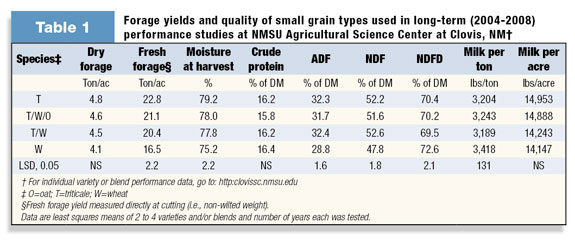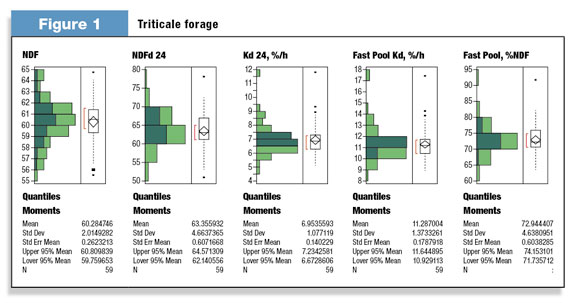Triticale (trit-e-kay-le) has been a commercial crop for 42 years. At first, most varieties were dual purpose for grain and forage, and the original intent was to develop triticale as a food crop. However, the realities of the difficulties and expense of changing our food culture soon dawned on us. While bread and other wheat-like products are still a goal, it soon became apparent that to survive, we needed to develop triticale as a forage.
Today, approximately 700,000 to 800,000 acres are being grown for grazing, hay and silage. The biggest growth in acres for the past 10 years has been as a dairy silage. At first, triticale was mostly fed to dry cows and heifers, but now it is increasingly being used in the milk ration.

The New Mexico State University Agricultural Science Center at Clovis, New Mexico, began conducting triticale forage research in 1973. Dr. Mark Marsalis, extension agronomist at the station, summarized the past five years of data into Table 1. You will notice the significant increase in tons per acre of triticale over wheat and that triticale produced the most milk per acre.
Using the standard accepted chemical analysis methodology, wheat should produce the most milk per ton of silage. However, some dairymen’s experiences have shown that the two crops can be equal in nutritional value. There is very little university data that makes a direct comparison of laboratory quality and feedout performance. Dr. Gary Burke at the University of Arkansas in 1984 stated that Ace wheat and Grazerblend triticale were basically of equal value in his in-vitro digestion study, but the triticale produced 30 percent more dry matter per acre.
At Ohio State, Weiss et. al. determined that triticale and corn silage were approximately equal in producing pounds of milk per ton of silage. In June 2010, using Cornell University studies, Dr. Tom Kilcer stated that flag-leaf stage triticale silage was better than BMR corn, and soft-dough silage was equal to or better than conventional corn silage at producing milk.
I asked several dairies what their experience was from feeding triticale in their milk ration. The first one was my neighbor Hinders Dairy, founded by Louis Hinders in 1952, and now managed by his son David. They first grew triticale about 20 years ago for grazing on their dryland farm and for dry-cow hay. In 2002, we had a wet spring, and the triticale looked like it had been irrigated. Not used to such bounty (it was 2007 before they again had a surplus of feed), David asked his uncle, Dr. Ray Hinders, to formulate a milking ration using triticale silage. Not only did the milk production hold up, the protein went up a point. Louis says they like to use wet rolled milo with triticale silage because that combination gives them high production with higher-than-normal milk components, and therefore a bigger milk check.
Vic Lutz of New York has two happy customers in Stein Farms Dairy and Weaver Dairy. This year, when the Steins started feeding the new-crop triticale, milk production increased two pounds per cow. They try to feed 15 to 20 pounds (wet weight) triticale silage and say that triticale is the least-cost forage they grow. Eli Weaver agrees. He feeds 10 to 15 pounds dry matter (DM) triticale per day and tries to keep at least 67 percent forage in his ration.
Bill Van Beek in California has been using both boot-cut triticale and soft-dough triticale silage in his ration. He likes to feed the boot-cut silage in the summer as the cows consume more feed, so milk production holds up better.
The best answer to triticale’s value may be in the work of Dr. Charles Sniffen, who taught at Cornell University and Michigan State, and who now runs Fencrest, LLC and has studied triticale extensively. He sent me the following letter, which explains the idea of fast-fiber digestion.

“Triticale forage is, in nutritional terms, an amazing forage. Figure 1’s data are from plots grown in Pennsylvania and North Carolina in 2009. The samples were analyzed with in-vitro digestion at a well-known forage testing lab. The graphs are frequency distributions of the analysis. The tallest bars reflect the greatest number of observations of a particular analysis. The average Kd 24, %h, 7&8 %h were selected to highlight the average Kd (rate of digestion) for the triticale. The results in different areas are highlighted in the other graphs. This is a very high rate of digestion, and in a typical high-producing ration, will mean over 53 percent of the fiber will be digested in the rumen, which is quite high.
“What is of great interest are the rest of the distributions. The highlighting of 6.5 to 7.5 Kd resulted in the highlighting of different areas in the other distributions. Importantly, the high-fiber digestibility can occur across a wide range of NDFs. Equally, it does show the importance of the need for forage analysis, given that not everything is highlighted. The NDF digestibilities are in the 60 to 70 percent range. This introduces a relatively new concept called ‘fast pools.’
“Forage fiber is of two types: that fiber that digests very rapidly in the rumen and those which digest slowly. We all know that BMR corn silage has fiber that digests very rapidly in the rumen, allowing for great intake. Triticale does too, and on average, 73 percent of the fiber is fast fiber. What this means is that this fiber will disappear rapidly in the rumen, allowing the cow to eat another meal and will actually stimulate more frequent meals. Because of the nature of this fiber, it also means that the NH3 produced in the rumen will be more efficiently used, microbial growth will be greater, and rumen pH will be more even throughout the day. The fast pool Kd of 10 to 12%h assures a very good digestion in the rumen, rumen balance, and in the end, a healthier cow.
“Because triticale is a multi-use crop that produces more tons per acre of feed, this allows a dairyman to have more high-quality, low-cost feed on hand and will let the dairyman increase the amount of forage in the diet. At the end of the day, triticale is a forage to seriously consider using on your dairy.”
All to which, I say Amen. PD
The information used in this article is about triticales that were bred for forage and are protected by the Plant Variety Protection Act. This information may or may not hold true for generic public varieties. Bill Smith (bill.smith@syngenta.com), and Gene Aksland (gene.aksland@syngenta.com) helped gather information used in this article.
Ron Kershen is a researcher withTriTicale Consulting. Email Ron Kershen.





